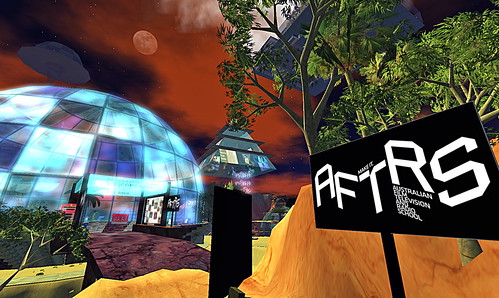Gary Hayes has amazing talent. As with so many people who are masterful in their field, he can make the difficult look effortless. However, this time it’s not an attractive and engaging machinima or build that has me excited, but Gary’s words about the new diploma courses being run at AFTRS.
Forget the glitz and glam, ignore the special effects of the promo videos if you are able. Look, feel and presentation are required elements of film, animation, games and virtual worlds. Nonetheless, the promo video for these courses overshadows something that I feel is of far greater importance: these one year graduate diplomas in Games Design (Directing) and Virtual Worlds (Directing) have great technical depth.  Each has been rigorously designed, will be delivered with the intensity and creativity of amazing mentors, and behind each stands a wealth of knowledge concerning both presentation and mechanics.
The new courses will build upon the work performed within the Animation (Directing) course and the LAMP (Laboratory for Advanced Media Production) initiative.
What does ‘directing’ refer to?
The directing portion of the course titles refers to the fact that participants will be taught, in addition to the technical and business aspects, creative leadership skills, and the skills of innovation and entrepreneurship. Students will be expected to pioneer new ideas and thoughts, to create games and worlds never seen before, and they will be mentored in these endeavors. Originality, and the ability to push the envelope, are key. Students must be seen to be creating the future, not just contributing their small part to a company or the community. The focus of the courses is innovation: brand-new genres and interactive, film-like spaces – things which rarely even pass go in the risk-adverse computer games industry.
Games Design (Directing)
In the context of this course, a ‘game’ is defined as “authored or artificially constructed play”. Game formats and genres of a multitude of types will be considered in the course, from casual to serious/simulations, from console to online multi-player, from children to adult, and so on through hundreds of sub-categories. New gaming tools, such as emotional AIs, natural generative dialogue and realistic motion will be covered also. Significantly, game theory will be covered in-depth, and will be given as much importance as the creation of dramatic depth and visual intensity. Students will be expected to study and understand such things as gameplay and usability before they are let loose with visual and audio tools.
“We love games that have play and story at their core and not just great graphics or deep sound.” – Gary Hayes.
Here is an indicative list of the types of topics that will be covered:
Games Story, Character Design, Games in Motion, Storytelling Essentials, Game Level Design, Mechanics of Play, Cross-Media Incubator, Designing Story Worlds, Acting for Animators, Directing Voice Performers, Genre Workshop, Innovation and Form, The Business of Games.
Virtual Worlds (Directing)
Students will be learning to construct virtual worlds. Social worlds and MMORPGS will be covered, as will film pre-visualisation tools and CG-animated story worlds. Film/virtual world cross-overs will be covered in depth.
“We will also have lecturers from across the Australian and international metaverse industry involved in Virtual Worlds who understand financing, finding your market and target users and of course insights into the technical deployment of large scale community driven worlds. So from the outset students will understand how decisions made at napkin, sketching or proof of concept stages can have enormous impact further down the production chain. Each course will have several small incubator projects but the final major project spread over 13+ weeks, will include extra help in project managing rapid and complex productions.” – Gary Hayes.
Here is an indicative list of the types of topics that will be covered:
Designing Story Worlds, Virtual Camera, Social Virtual Worlds, Storytelling Essentials, Virtual Life, Cross-Media Incubator, The Avatar and Interface, World Design, Acting for Animators, Genre Workshop, Directing Voice Performers, Innovation and Form, Episodic Storytelling
“Eventually games are going to be designed in the same virtual space as the film will be.” – Peter Giles.
An especially exciting part of the two courses is the space in which they overlap. Components of each of the Games Design and Virtual Worlds courses will also focus on film production, the involvement of games and virtual worlds in film production, and the cross-pollination between games, virtual worlds and films.
“What makes these courses unique will be the cross-over with the film craft and directing parts of the school.” – Gary Hayes.
A range of professional associates will be employed during the period of the courses, including Matt Costello (Doom, Pirates of the Caribbean), John Buchanan (ex EA Games Research and Development) and Deborah Todd (author of Games: from BlueSky to GreenLight).
The one caveat I would like to issue about these courses concerns their length – just 32 weeks each. Courses run by the AFTRS are well known for their intense nature, and these will not differ in that manner. If you do join the student body, don’t plan on having any sick days – legitimate or otherwise.
See here for the video promo for the Games Design (Directing) and Virtual Worlds (Directing) diploma courses.
See here for a GameFilmWorld crossover video which Hayes produced to highlight the cross-over between the three.

Speak Your Mind